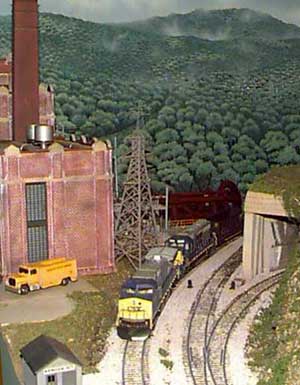The Cincinnati & Southern Railroad
“The Queen City Route”
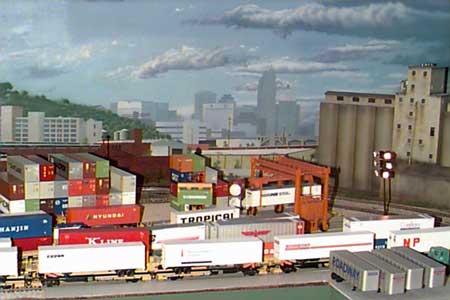
The inter-modal yard on Ted Waller’s Cincinnati & Southern is extremely busy on a hot day in July. TheCincinnati: The Cincinnati & Southern Railroad “The Queen City Route”
The Cincinnati & Southern is a fictional line which falls into the category of a “could-have-been” of the golden age of railroading. Developing out of the explosive growth of the Ohio River Valley in the years after the American Revolution the first tracks of the old C&S were laid by 1848 to serve the booming city of Cincinnati. At first the only connections were with agricultural areas along the north shore of the Ohio, but with construction of the first railroad bridges in the years preceding the Civil War, the C&S moved rapidly to tap the coal and iron resources of the Northern Kentucky and West Virginia.
By the turn of the century, strong alliances were in place between the C&S and the C&O. Because of stiff competition by the Pennsylvania and the New York Central, this alliance was strategic to the C&O’s access to car loadings from both the South and the Midwest. The C&S thus became by proxy a part of the C&O network until it’s eventual absorption into the C&SX in the 1980?s.
The old C&S historically served the agricultural hinterland of southern Ohio and the coal and iron centers of northeastern Kentucky. This layout focuses on these fictional operations, with interchanges with the parent CSX, Conrail, and Norfolk Southern. The C&S runs the same rolling stock as the CSX. C&S locos wearing CSX paint have a small “C&S” lettered under the cab-side loco number for identification. The loco shops and main yard area located in Cincinnati, and then the line reaches south to Augusta, Ashland, Olive Hill Kentucky, Ironton, Ohio, and Huntington, W. VA.
The Layout
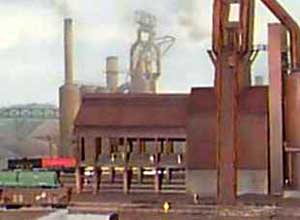
A large steel mill at Ironton consumes much of the C&S coal as well as providing the line with carloads of coil steel.
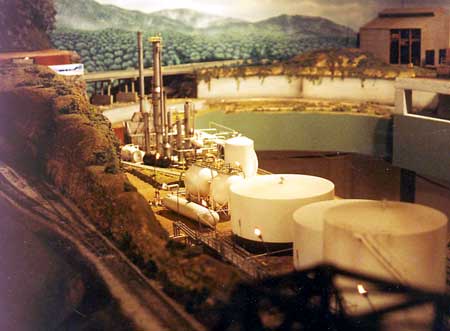
The Ashland Oil refinery at Ashland, Kentucky provides a strong revenue base for the C&S, as do Ashland’s Arch Coal subsidiary mines in the surrounding hills.
The C &S is designed for walk-around, multiple train operation for 1-4 operators. There are only two removable benchwork sections for access to a utility room and to allow interchange operations. Access top the central aisle of the layout is by way of an 18-inch duck-under. Access to room features such as the electrical cabinets have been maintained by keeping the benchwork either clear, lift-out, or narrow. The layout is constructed in modules to allow easy transport to the site. Construction is of wood and polystyrene foam with adjustable legs. Masonite and Sintra, a flexible plastic material, were used for profile fascia. The track is Walthers Code 83 Flex and turnouts and the control system is System One DCC with all locos, turnouts, and even signals. Dr. Waller will also plan to add computer scheduling and dispatch in the future. Turnouts are all driven by Circuitron Tortoise motors that also control point polarity.
The structures for the layout are both scratch-built and derived from popular kits from Walthers, Life Like, Smalltown USA, and Design Preservation Miniatures. The backdrops, expertly painted reflect Southern Ohio and the mountains of Kentucky and West Virginia, and are taken from actual photos of the area.
One of the many highlights of the layout is the fictional Ironton Works of United States Steel utilizes the entire steel complex from Walthers Cornerstone, and is backed by a detailed backdrop showing 2 additional blast furnaces. An open-hearth furnace complex, scrap yards and other structures taken from the pages of Dean Freitag’s book on steel making also appear on the layout. There is also a refinery complex that utilizes a combination of the Walther?s North Coast Refinery with the Plastruct refinery kit that simulates the Ashland Oil refinery in Ashland, Kentucky. All cracking towers, the entire refinery, and tank farm are realistically lit for night operations as well.
In the Cincinnati area, there is a realistic portrayal of the Procter and Gamble complex and even the new Olestra, “fat free fat” plant painted on the backdrop. There is also a sizable inter-modal facility, a large grain elevator, and several other major industries realistically portrayed.
Coal, however, is the lifeblood of the C&S and there are no less than three car-loading operations on the layout. Two flood loaders service two different pits at the top of Cal’s Knob, a 40″ high mountain which is penetrated by a long tunnel concealing staging tracks for the layout. The third mine operation is an underground adit mine at Olive Hill that provides several types of specialty coals for industrial uses. The large sorter/crusher is the Walther’s New River Mine with minor modifications. Other highlights include a large power plant with a working car dumping unit, an auto plant and a large limestone operation that also feeds the steel mill at Ironton.
The layout sports working signals, block and crossing, and all structures and streets are lit for night operations. There are many mini-scenes throughout with over 200 figures going about their day’s work. More are being added each week.
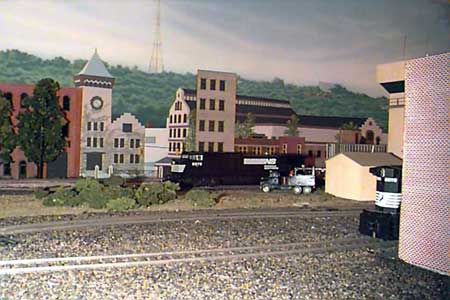
A Norfolk Southern C44-9W rolls past the Corporate offices of Proctor & Gamble in Cincinnati on trackage leased from the C&S. P&G is one of the biggest employers in Cinci and also the source of the revolutionary fat substitute trade named Olestra. Tank cars roll in and out daily. This unit is pulling an interchange train of empty double stack cars to the inter-modal yard.
The Management
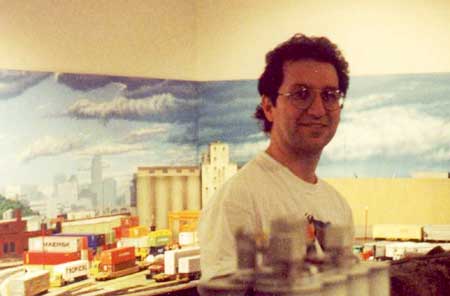
Dr. Waller in the “bullpen” near the auto plant and intermodal facilities at Cincinnati on the “Queen City Route”
The CEO of the C&S is Dr. Ted Waller, M.D. a noted Cardiologist from Cincinnati, Ohio. Ted is founder and partner in Ohio Heart, P.C. which is in the forefront of treatment of all forms of cardio-logic conditions. Ted grew up in Ashtabula, Ohio, where he had daily jaunts to the lake shore to watch the trainloads of coal arrive for loading onto lakers (lake freighters)and salties (ocean-going ships) for trips to all parts beyond. Ted has always had the desire to have a “serious” model railroad, and had been amassing a collection of track, rolling stock, and structures to realize his dream. Unfortunately, the various requirements of medicine, his practice, and his wife Debbie and four wonderful kids (Josh, Allison, Katy, and Jason, in order, by age) made it impossible for him to realize his goal without the help of RailDreams. During a visit with Ted in Cincinnati, Dick Taylor and he worked out the basic design of the line by visiting and photographing various areas around Cincinnati. Then Dick went down to Kentucky and West Virginia on a layout delivery trip and took photos of key areas around Ashland, Huntington, and others to get just the right feel to the layout. Throughout the process of design and construction of the C&S Ted and Dick worked closely to make it reflect the look and feel of its service area.

